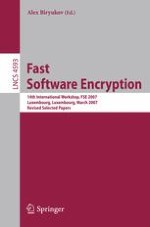2007 | Book
Fast Software Encryption
14th International Workshop, FSE 2007, Luxembourg, Luxembourg, March 26-28, 2007, Revised Selected Papers
Editor: Alex Biryukov
Publisher: Springer Berlin Heidelberg
Book Series : Lecture Notes in Computer Science
